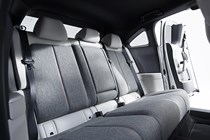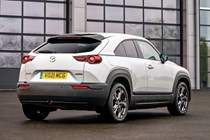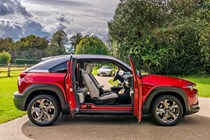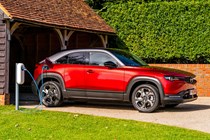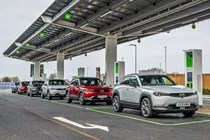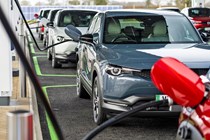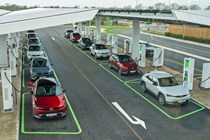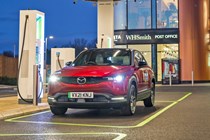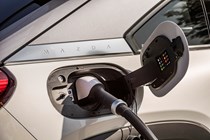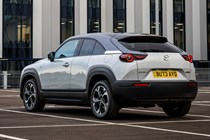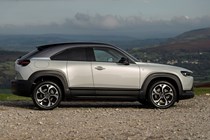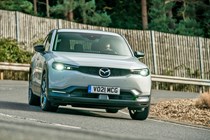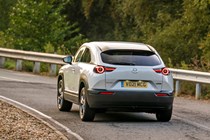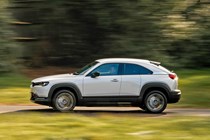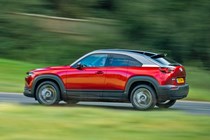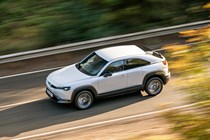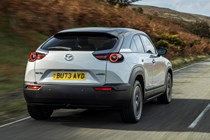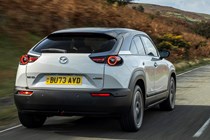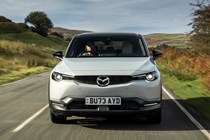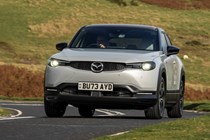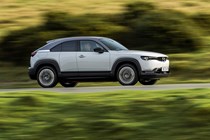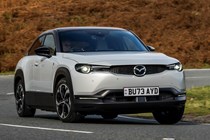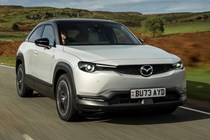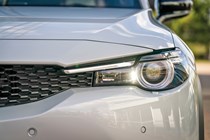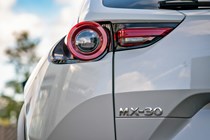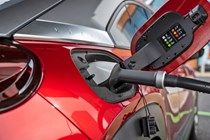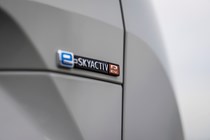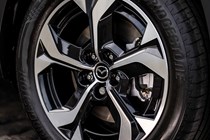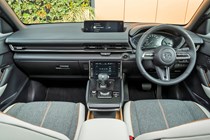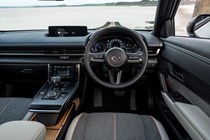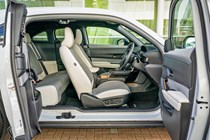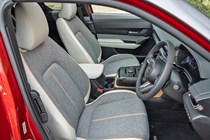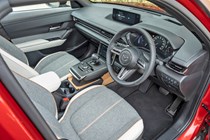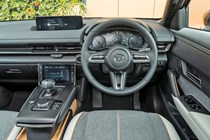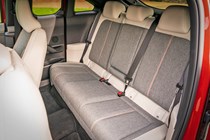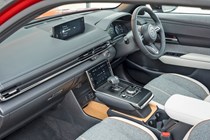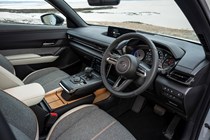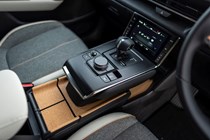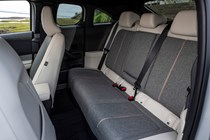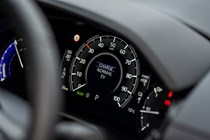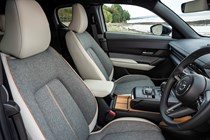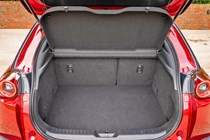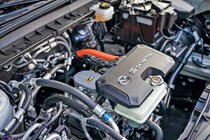
Mazda MX-30 SUV (2020-2025) long-term test
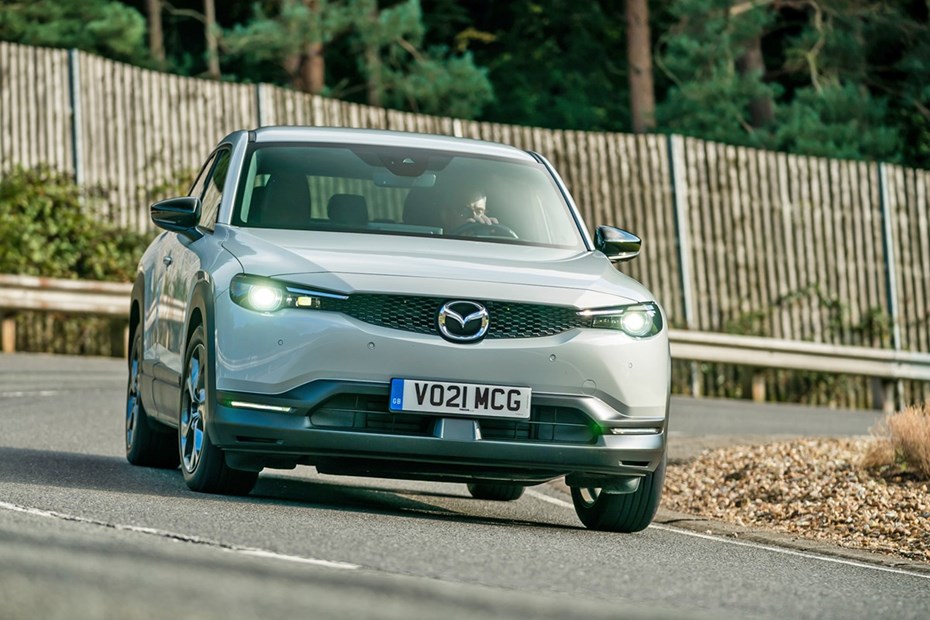
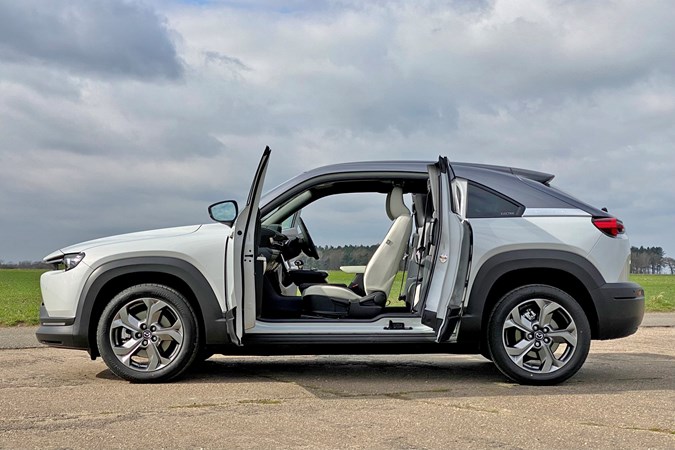
Mazda’s first electric car is an unusual compact, coupe-like SUV with what its maker calls a ‘right-sized’ battery. We’re spending 12 months with the MX-30 to determine, among other thing, whether it is the correct size or marketingspeak to disguise the fact it’s too small.
Reports by the Parkers team
Jump to:
- Welcome to Parkers
- Charging at home
- The joy of specs
- Sound and vision
- A winter warmer?
- On a long journey
- Conclusions
Update 1: Welcome to Parkers
Proving that cars which are difficult to define bristle with appeal
It’s an incredibly difficult car to pigeonhole, Mazda’s MX-30.
Simply labelling it as an SUV or an electric car tells only part of its story, for it’s also city-focused, an enjoyable companion on winding back roads, useful for families with young kids as well as being coupe-esque in shape.
You’d be forgiven for thinking that without a clear identity that Mazda couldn’t possibly hope it would fulfil any of its roles particularly well, yet almost a thousand miles in, its keys are proving to be the ones I grab the most often.
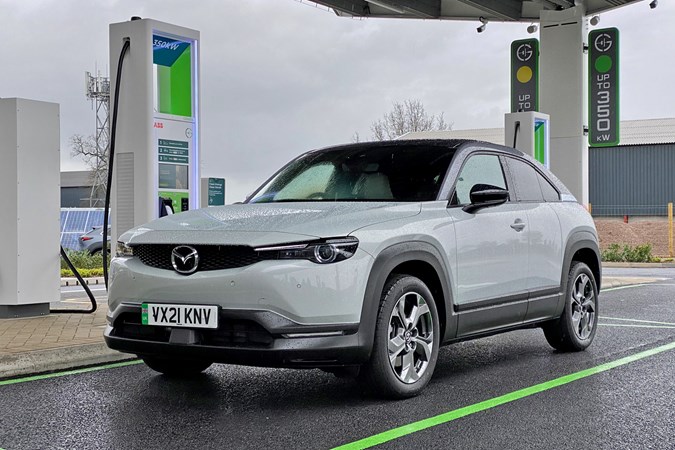
To determine whether this is more than just a honeymoon period, I’ll be running the Mazda for Parkers over the next 12 months, seeing whether it can really fit in with my life, given neither me or my family set-up are the primary target market.
Which MX-30 are you running?
Somewhat unusually, Mazda expects the top-selling MX-30 to be the range’s flagship – the somewhat ambiguously titled GT Sport Tech – so that’s what I’ve opted for here.
After the £2,500 government plug-in car grant has been deducted, it retails at £30,345. That’s £2,300 more than the mid-ranking Sport Lux and £4,300 pricier than the entry-level SE-L Lux.
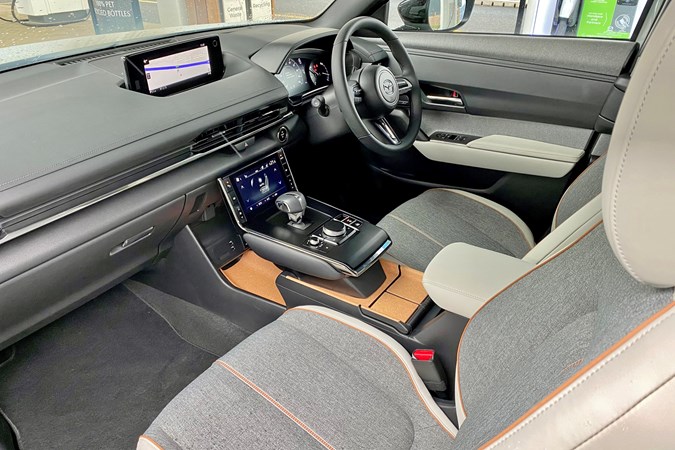
I’ll be poring over the intricacies of the trim levels in a future update to determine which MX-30 represents the better value, but at this early stage it’s worth noting that the GT Sport Tech is the only model in the range that comes with the following equipment:
- Adaptive LED headlamps
- Electric tilting and sliding glass sunroof
- Front wiper area de-icer
- Heated steering wheel
- LED tail lights
- Upgraded safety equipment including Cruising Traffic Support (CTS), Driver Monitoring (DM), Front Cross Traffic Alert (FCTA) and Smart Brake Support – Rear Crossing (SBS-RC)
- Three-pin plug socket on the dashboard
- 12-speaker Bose surround system audio upgrade
Given the generosity of the levels of standard equipment, extra-cost options are few and far between – in fact, of the two available, I only plumped for one.
At £1,500 the three-tone paint option – Ceramic metallic bodysides, Dark Grey metallic roof arches over the side windows and a Brilliant Black roof centre – seems somewhat extravagant, but for me this is the MX-30 looking its best. It brings the post-grant deduction price of this one to £31,845.
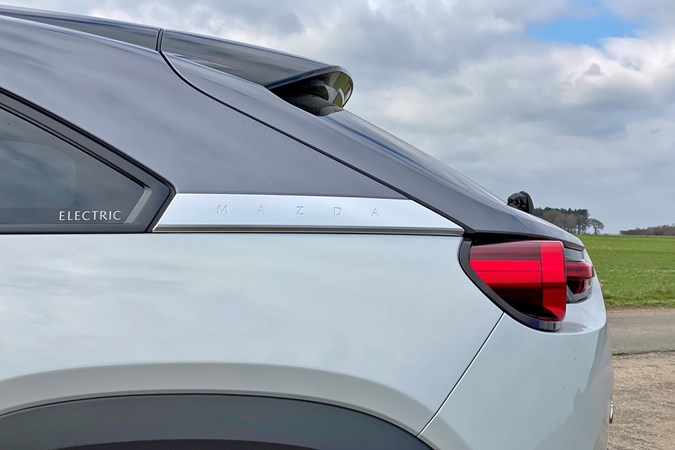
Combined with the unpainted plastic wheelarch and lower bodywork mouldings, the pale paint of the main fuselage looks lower and longer, making the MX-30 difficult to judge size-wise in isolation. For reference, it has an identical footprint to Mazda’s more practical CX-30 SUV.
And the option I didn’t go for? Mazda charges an extra £200 for a dark brown and grey interior colour-scheme, but I prefer the pale grey and copper finish it has as standard. It complements the exterior better and makes the interior feel less dour, particularly in the back.
What’s right-sizing all about?
Fitting the MX-30 with a battery capacity of just 35.5kWh does seem a misstep, with ‘right-sizing’ being the marketing line trotted out to defend it.
Not so, says Mazda – it’s all about making the MX-30 carbon neutral much sooner in its life, plus most people only cover shorter journeys most days – in which case, hauling a big battery around doesn’t make much sense.
Whatever you think of it, it automatically ensures that in terms of range – Mazda quotes 124 miles in the official test – it’s more of a rival to Honda’s e and MINI’s Electric Hatch rather than similarly sized SUVs in the shapes of Peugeot’s e-2008 and Vauxhall’s Mokka-e, both of which have a real-world range close to 200 miles.
If you know from the outset that you’re regularly going to be taking journeys of more than 100-120 miles, then the Mazda’s going to be a right pain, not right-sized. But if you don’t, and you’re happy to spend about an hour recharging in order to complete occasional long journeys, then there’s little reason why it couldn’t work.
Those Freestyle doors – just a gimmick?
Most friends and family I’ve shown the Mazda to so far are initially wowed by the MX-30’s door arrangement, where the slender pair of rear ones are hinged at the back, and can only be used when the front ones are already opened.
In reality, a cool as they look, they’re only really acceptable because of its coupe-aping roofline – if it was an SUV of more conventional proportions, such as the CX-30, then the doors would open, well, conventionally.
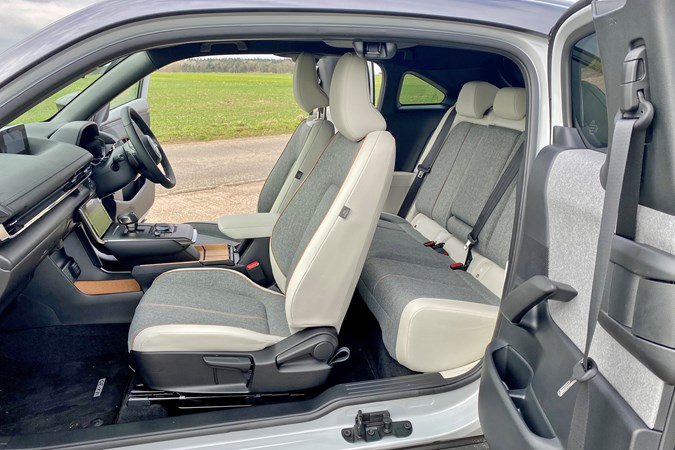
As an alternative to a three-door car, which the MX-30 would otherwise be without them, they do make sense . Two smaller doors on each side take up far less space to open in tight car parks than the much longer doors normally associated with three-door models.
Only scrabbling smaller kids and lithe, flexible adults can get into the back via the narrow gap without moving the front seats forward. If you’re ferrying at least two other adults about most days, while whoever’s in the back should have ample legroom, it’s a faff getting them in and out.
Positive first impressions
Despite those idiosyncrasies – or maybe because of them – life with the Mazda’s proving enjoyable so far, not least because of how it drives.
Progress is brisk enough to annoy hot hatch drivers as you pull away from a slow bend, but it doesn’t feel needlessly quick, with the neck-snapping acceleration of some other electric cars. Besides, hooning EVs around really does deplete the battery, reducing range as a consequence.

It’s engaging, though – there’s a useful degree of feedback through the steering, the weights of the controls feel reassuring and the handling itself is neat and tidy, allowing swift cornering with little drama.
So far, the indicated range seems accurate at any given moment, with no sudden drop-offs that I’ve experienced in other electric models, and while 2.8 miles for every kilowatt hour (kWh) of battery isn’t stellar, that includes a lot of national speed limit driving.
There’s one slightly annoying development, though – a buzzy, platicky vibration from somewhere near the rearview mirror. I’ll need to get that looked at before I’m cranking the Bose speakers right up.
Mileage: 968
Energy efficiency: 2.8 miles/kWh
Update 2: home charging
Domestic charge points allow owners to make the most of electric car ownership
Talk to people with little to no experience (yet) of EVs – as I frequently do – and the most common perceived barrier to them taking the electric route for their next car is a lack of charging infrastructure.
This is a topic I’ll return to in an update in the coming months, but whether that perception is right or wrong is almost immaterial.
What it anecdotally demonstrates is that the automotive industry still requires a huge educational shift with would-be EV owners to alter the train of thought that because they currently go to a specific type of place to refill their petrol and diesel cars, they’d have to do something similar with an electric one. And wait for an hour or two to do so.
Those who have already embraced electric cars know differently – the answer is a domestic wallbox to charge it up, usually overnight. Think of it this way: imagine starting your combustion-engined car each morning to find the tank had been brimmed overnight. Rather appealing.
There’s a caveat here, and one which will require some free-thinking by those responsible for the EV charging infrastructure in the years to come before 2030 – not everyone has the ability to charge their car at home, due to a lack of a private driveway and designated on-street parking slots. If you do have such amenities, a dedicated wallbox is the way to go.
Mazda in partnership with NewMotion
Many car manufacturers partner with a charging solutions company for domestic wallboxes and Mazda is no exception.
It has linked with NewMotion, part of the Shell group, to supply its stylish dedicated EV charging units. Ordinarily these retail at £549 (including installation) for the standard Home Fast package, but order an MX-30 before 30 June 2021 and it’s free of charge.
Additionally, you can upgrade to a Home Advanced unit that looks very, but has extra features, such as the ability to approve charging requests to those with specified RFID cards – that model costs £649.
You can also spend extra to have the plastic shell of your wallbox in a colour other than the standard off-white, as well as having a tethered cable – more on that below.
Covid-affected home survey
In the years BC – before Covid – before a domestic charge point could be installed, the appointed electrician could check various aspects of the property to verify its suitability. Where it wasn’t up to scratch, you would additionally be quoted for remedial work before the installation could go ahead.
Like most aspects of life since the start of 2020, things are different just now. Instead it’s the customer’s responsibility to complete a virtual survey.
NewMotion’s website talks you through the process step-by-step, with the primary requirement being to upload photographs of various elements, including your electricity meter, existing consumer unit, confirmation that any gas and water feeds into the property are appropriately earthed and your preferred charge point location.
It’s imperative that this is done properly to save yourself from disappointment later.
An installation engineer will look at your images and ask you to send further ones if what they need to see isn’t clear. Failure to do so will result in your installation being held up.
According to the electrician who installed my unit, the virtual survey is actually a positive aspect, typically saving 45 minutes of time per visit.
Straightforward installation process
Okay, I’ll be the first to admit that installing a chargepoint in a relatively recently built detached house means there was more likelihood of it being an easy task than if I were in a Victorian mid-terrace. Even so, the whole process took little over 90 minutes.
I’d decided to have the wallbox installed just inside the garage door, primarily because I’d ordered the optional (£170) 8-metre tethered cable and I didn’t want it to look untidy or unsightly on the house’s exterior. A tethered cable was appealing as the Mazda won’t be the only plug-in car I have on test at the property, meaning there’s a convenience using a single cable rather than one from specific vehicle.
You can also choose to have the wallbox mounted on a specific pole if you wish, which might make more sense if your driveway isn’t adjacent to the property.
All in there was less than 15 metres of cable used for the installation, the relatively short distance and the route it took (in a loft space above the garage) speeding the process up.
An additional RCD box specifically for the wallbox was wired in just above the existing consumer unit, the cable then looping overhead and back down to the unit’s location. It’s all very neat and tidy.
Simplicity itself to use
Once it was all tested and okayed for use, the wallbox really is simple to operate – literally no more than plugging the cable into a car’s charging port.
Immediately when plugged in, a light on the wallbox glows green while it and the car communicate with one another. Moments later, with everything determined to be fine, the charge begins and the light turns blue. Once the charge is complete the light extinguishes.
How much it will cost to recharge a car domestically depends upon how empty the battery is, what its maximum size is and how much your electricity costs per kWh. As the Mazda MX-30’s battery is compact at 35.5kWh, on my current tariff the maximum it would cost to recharge is £5.20, but it’s unlikely ever to be completely flat when it’s plugged in.
Helpful web-based dashboard
In order to keep tabs on your electricity consumption, the NewMotion website has a customer portal to allow you to track all of your charge sessions, useful for deducting the cost from your overall bill such as for claiming back expenses.
Through this dashboard you can also adjust settings, such as making the charge point available for members of the public to use (I haven’t before you roll up…) or to allow the unit to operate without needing to be activated by an RFID car, something I have done given its inaccessible when the garage door’s shut.
So, how useful actually is it having a domestic charger? Well, around 1,600 miles in and I’ve charged it publicly four times compared with 34 occasions it’s been hooked-up to the wallbox. The portal also tells me I’ve so far consumed 398kWh of electricity so far at a cost of £58.35 – for approximately 1,400 miles of driving.
Compare that with how much you’d spend on petrol or diesel to cover a similar distance – is an EV still looking unattractive?
Update 3: The joy of specs
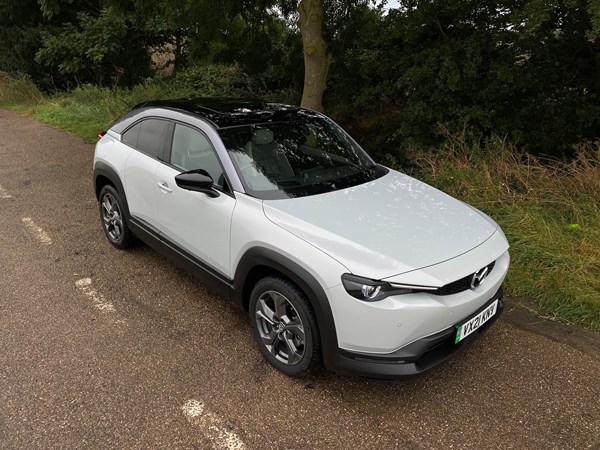
It’s rare that range-toppers are bestsellers, but the MX-30 breaks this rule, too. When it comes to cars, most people in most instances will plump for a mid-range model, typically with a few extra-cost options that edges it closer to the next model up the trim level hierarchy ladder.
Entry-grade models with a paucity of kit are rarely bought – their sole purpose in life is to legitimise advertising an attractively low starting price in promotional materials. Most car salespeople will steer you away from buying one, too, as they know it will be an unattractive pain in the proverbials to sell as a used car when you trade it back in.
It might be the cheapest model in the MX-30 line-up, but SE-L Lux hardly sounds like a hairshirt specification level. In truth, it isn’t – so generous is the kit roster that there’s space below it for one or even two cheaper trims should Mazda feel the need in future.
What equipment for your bucks?
Despite that, Mazda’s forecast is that the range-topping GT Sport Tech – the version we’ve got here – will be the bestseller. It’s £4,300 more expensive than the SE-L Lux, which is mechanically identical, so by and large the differences relate to either superior technology or superficial differences. So, is it worth going for the flagship MX-30?
Inevitably, it’s not that straightforward, primarily because there’s the middle ground of the Sport Lux trim level for just £2,000 more than the SE-L Lux. That outlay brings with it some additional interior chrome and exterior gloss black décor, but more tangible features, too:
• Auto-dimming driver’s door mirror
• 18-inch alloy wheels
• Rear privacy glass
• Light-grey fabric and faux leather upholstery
• Eight-way electrically adjustable driver’s seat with memory function and lumbar adjustment
• Heated front seats
• Keyless entry and starting
Those features do make the MX-30 even more appealing and special, which makes the real question is the Sport Lux the one to go for or can the GT Sport Tech’s extra kit and £2,300 cost be justified?
After a few months and approaching 3,000 miles behind the wheel I’ve been able to draw some firm conclusions:
• Front wiper de-icer – given that since I’ve been running the MX-30 the temperature hasn’t dropped below zero, this is something I’ve yet to be able to test. I’ll report back as winter approaches, but I can’t imagine it will be as satisfying as Ford’s electrically heated windscreen.
• Adaptive LED headlamps – all MX-30s feature LED headlamps with automatic main beams, but here their angle of illumination varies depending upon steering wheel direction and speed. Combined with fast-acting main beam lights that cut out sections of illumination to avoid dazzling other road users, they’re proving very welcome, especially on unlit, windy B-roads.
• Signature LED rear lights – again, all MX-30s have partial LED illumination at the back, but with the GT Sport Tech it’s pure LED. Safer, yes, but it also looks great – and I’m erring with the vanity aspect here.
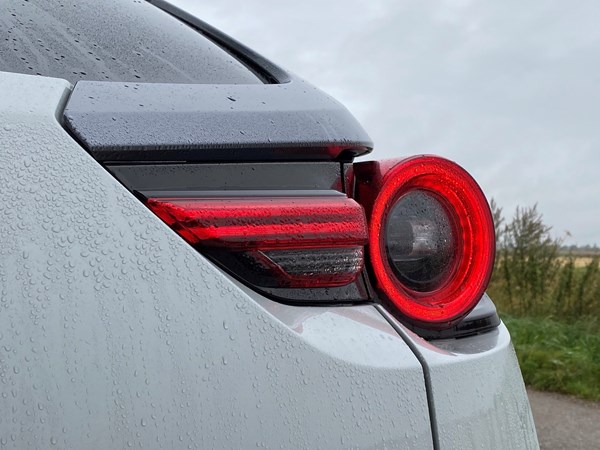
• Heated steering wheel – see front wiper de-icer above.
• 12-speaker Bose surround sound system – I’m no great audiophile, and a dozen speakers sounds like overkill in a modestly sized cabin – that is until you use it. Its sound reproduction is rich and clear, amplified at low speeds when there’s virtually no other noise from the car. Really impressive and a doddle to use the Mazda’s wheel-mounted controls on the move, too.
• 150W three-pin plug socket – imagine those times when you’ve an hour to kill while the MX-30’s being recharged, so you take the opportunity to turn on your laptop to send a vitally important email, only to find it’s run out of battery life. Yep, I was there, but having the power cable on me saved the day. My only gripe is its awkward location under the centre console.
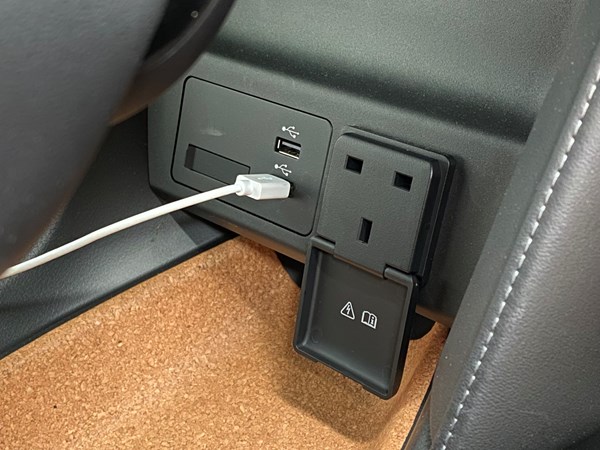
• 360-degree View Monitor – one of the best four-camera, all-round set-ups I’ve experienced this, making it supremely easy to nestle into tight parking spaces.
• Driver Monitoring (DM) – useful safety feature that monitors facial expressions and the driver’s line of sight, recommending a break if it detects tiredness. It’s also a convenient instruction to stop for a vanilla latte.
• Cruising Traffic Support (CTS) – subtly complements the excellent adaptive cruise control system fitted to all MX-30s, by maintaining smooth driving assistance in heavier traffic conditions. In fairness, I need to drive a model without it to determine the benefit of its presence here.
• Front Cross Traffic Alert (FCTA) – especially useful if, like mine, your driveway exit is flanked by hedges making it trickier to see what’s coming from the left or right. Being able to switch the front-facing camera from normal to wide-angle also comes into its own here.
• Smart Brake Support – Rear (SBS-R) – not a safety system I have any desire to try out, but reassuring knowing it’s there. When the MX-30 detects it’s about to become the victim of a rear-end shunt, the braking system is primed to deliver maximum stopping power to prevent it being shoved significantly forwards.
• Smart Brake Support – Rear Crossing (SBS-RC) – combining the previous two functions, this safety system has your back when reversing out of scenarios with poor visibility. Visual and audible warnings are accompanied by an automatic emergency stop if the system doesn’t think the driver’s heeding the incoming danger.
So, is the GT Sport Tech’s extra £2,300 a price worth paying? Excellent stereo and glitzy rear lights aside, the additional kit is essentially safety related, so ultimately it’s down to how much you’re prepared to pay for electronic insurance policies.
Can you be too safe, especially when some of that technology will help prevent accidents that impact on other drivers and their passengers? No, I don’t believe you can – for me, this is the MX-30 of choice.
What would get my vote is that the bundle of extra safety gear was available on all MX-30 grades as an optional Tech Pack, or even better, as standard fare across the range. Until then, MX-30 customers with a similar mindset to mine, will continue flocking to the top of the range.
- Mileage: 2,869
- Efficiency: 3.0mi/kWh
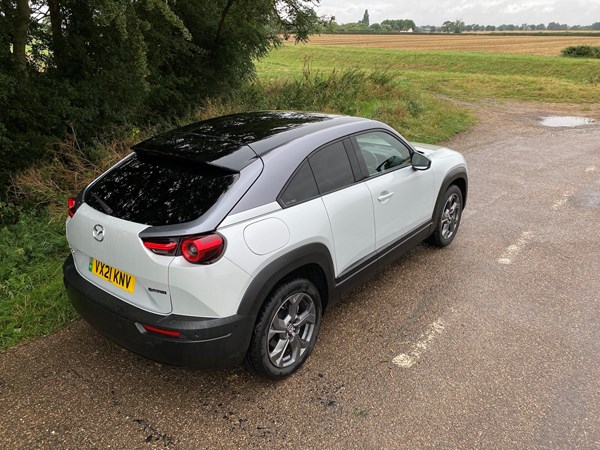
Update 4: sound and vision

As much as Keith’s enjoying life with the MX-30, a few niggles are creeping in
While Mazda purists may argue for hours on end that a ‘proper’ MX-badged model should be a sports car, not a low-slung SUV, the truth is it’s a car I often go out in for the simple joy of driving it.
Journeys with no specific destination in mind have become zero-emission indulgences, while school runs and jaunts to the shops feel far less routine in the MX-30.
Whether I’m enjoying the fluid handling, the quiet, soothing nature in which it goes about its business or the tactile delights of the classy interior, Mazda’s produced a car that I could spend much more time in than is strictly necessary.
Inevitably, the longer you spend with a car, the more you become acutely aware of small things that niggle and annoy – in this regard, the Mazda’s no different.
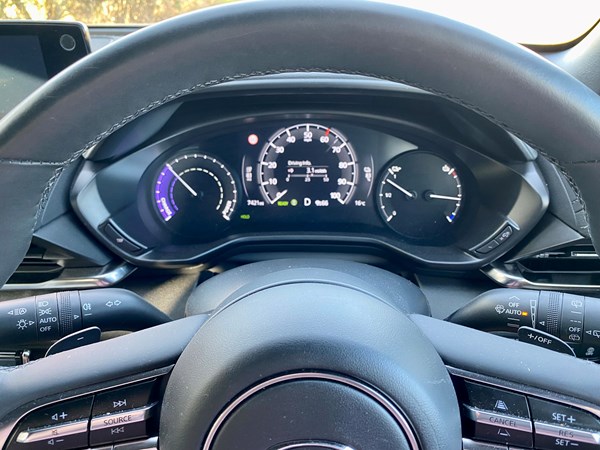
So, what specifically is getting on my wick?
Mazda’s fitted the MX-30 with an excellent pair of LED headlamps, with an automatic main beam function that operates very rapidly – annoying other road users with a dazzle is a rare occurrence.
Similarly, its automatic wipers seem to judge the level of precipitation brilliantly and rarely have manic moments where they default to their most rapid setting when it’s barely spitting.
Why, though, are the two systems not combined? Mazda’s not alone on not linking the lights and wipers, but it seems ill-judged that you could be driving through a torrential downpour, but because it’s not dark, the lights merrily remain in daytime-running mode.
It doesn’t make sense – in what circumstances would you not want your lights on in the rain? Sort it out, Mazda.
Getting rattled
As the summer approached and finally settled in, plasticky noises began to resonate around the MX-30’s cabin. Crank up Spotify and they’re soon drowned out, but on a journey when you really want to luxuriate in the Mazda’s soothing silence, they’re bloody annoying.
It didn’t take too long to narrow down the rattles caused by ever-so-slightly ill-fitting components to three areas.
Loudest of the trio is the hollow drone of the sunglasses holder just behind the rear-view mirror. When empty, it’s more noticeable on new, smooth sections of asphalt, but bung a pair of shades in it and they fill the sound void by vibrating on rougher road surfaces. A double-whammy.
Quieter, but more annoying, are the rattles that emanate from the plastic trims covering the area where the front and rear doors meet, and where the front seatbelts are mounted. I’ve still not ascertained precisely what’s causing it, but because it’s in close proximity to my right ear, it becomes tiresome very quickly.
Fingers crossed that as the seasons become colder, the plastics will shrink a little and the rattles will stop.
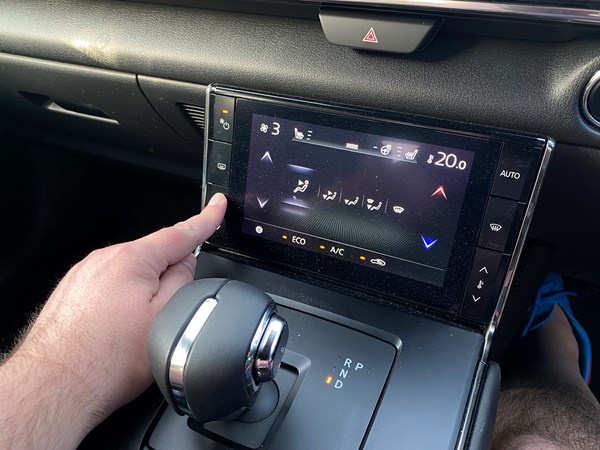
Keeping my cool
That the MX-30 only has single-zone climate control is no great hardship in itself, but it does seem to operate inconsistently when left to its own devices in Auto mode, my preferred setting.
On a warm morning, the air-con’s much-craved cooling doesn’t kick in unless you manually adjust the fan speed, yet later on in the day when the Mazda’s spent several hours soaking up the rays – and heat – flicking the temperature control while in Auto does make an immediate difference.
This only seems to be an issue when requesting lower temperatures – if you want to be warmer, it seems to work as you would expect it to.
Also, more than any other car I’ve driven in recent years, periods of stop-start driving, where there’s less of a natural flow of air coming in through the vents, seems to make the windows steam up rapidly. This soon dissipates when the ‘windscreen’ button on the climate control panel’s tapped, but again, Auto should be dealing with this.
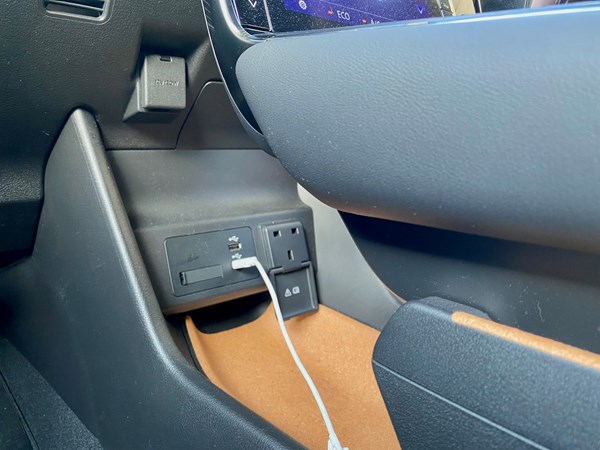
Plug and play
Just below that climate control panel is an elevated central console which is home to the stubby gear lever. Below is a usefully sized storage void, together with a USB port and a three-pin plug socket.
Unfortunately, the handiness of them is compromised by the panel housing the gear lever, making it really awkward to plug/unplug anything from the driver’s seat. The only way I can comfortably manage it is by squatting down from the passenger side.
Replacing the gear lever with some compact buttons and having the top of the storage void opened up would dramatically increase this space’s usefulness.
I must stress, though, that these negatives are minor in the grand scheme of things, which is more indicative of how appealing the overall MX-30 package is.
Yes, it’s appealing to quite a narrow band of potential buyers, thanks largely to the modest capacity of its 35.5kWh battery pack, which is something I’ll be looking at in more detail in the next update.
For now, I’m going to sign off – I fancy going for a drive just for the sake of it.
- Mileage: 4,244
- Efficiency: 3.2mi/kWh
Update 5: A winter warmer?
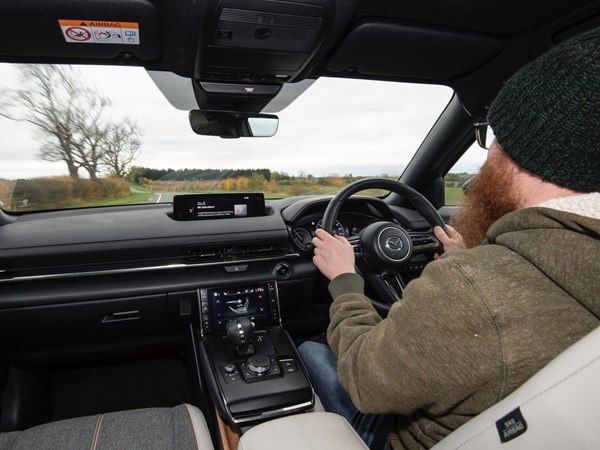
As much as Keith’s enjoying life with the Mazda, a few niggles are creeping in
With previous custodian Keith Jones off to pastures new, the long-term MX-30 was suddenly in need of a new keeper. While plenty of colleagues were wary of its range, I’m too brave/stupid to get range anxiety and besides, I had plenty of short journeys ahead of me during three weeks of paternity leave.
I expected the onset of colder weather to slash the MX-30’s range, but thanks to plenty of time spent away from motorways and on the rural roads of Norfolk I’m still able to get around 90 miles of range from a charge. Considering I have access to a petrol-powered car for longer journeys, that’s proved more than sufficient for my needs.
Remote control
Besides, with only a three-pin plug available to me at home it can take literally days to charge an electric car with a big battery. With the Mazda I know I can drive it during the day, plug it into an external socket overnight and it’ll be charged by the time I roll out of bed in the morning.
Not only is it charged, it’s also toasty warm thanks to the MyMazda smartphone app. Available for both Apple and Android, it lets me preheat the interior before I’ve even stepped out the front door, keep an eye on charge levels, locate the car and tells me when a service is due. It proved easy to set up while the ability to heat (or cool) the interior whilst still plugged in saves a little bit of battery power to maximise range.
It also ensures that even on the frostiest morning I’ve encountered I haven’t had to scrape ice off the windscreen. I suspect a thicker covering of snow would be a sterner challenge, although if you were up early enough you could just turn the heating on that bit earlier to clear it. Here’s hoping I don’t have to try that out, though.
What the app doesn’t let me do is turn on the heated seat and steering wheel. First world problems for sure, but they are wonderful additions to a car in the winter months. In my opinion, a heated seat warms you bones far faster than air from a climate control system blowing over you and having your fingers lightly toasted at the same time helps even further.
A touch too much
In fact, I’ve got into the habit of switching them on before I even start moving. That’s partially because I’m such a big fan, although it’s mainly down to them being operated through the touchscreen climate control panel pictured in Keith’s last update. It works fine when you’re stationary, but you have to take your eyes from the road for too long to change the settings when you’re moving.
On the whole I’m enjoying my time with the MX-30, finding it comfortable yet enjoyable to drive while possessing an interior that feels like it belongs in a far more expensive car. How well it copes with my young family is the next and possibly sternest test for it.
Update 6: On a long journey
Parkers editor Keith Adams decides to take the MX-30 to Scotland
Long story short – if you’re looking to take the MX-30 on a long journey, our advice is plan ahead, be prepared to take your time, and plan of lots of coffee…
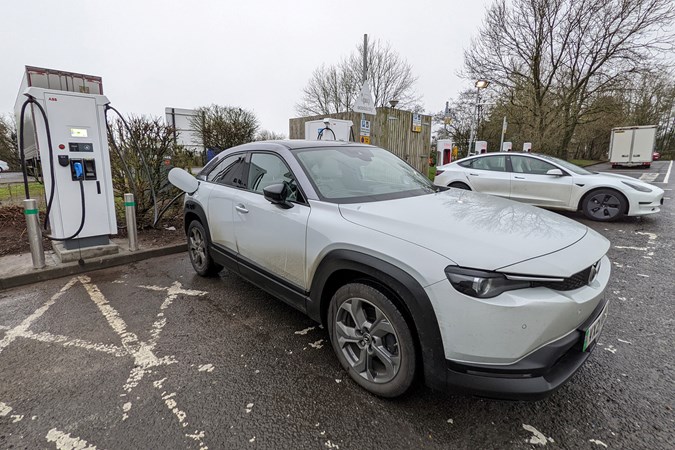
I’m sure that anyone who’s bought – or is considering buying – an MX-30 will be more than conversant with the limted range this car has. So, when I decided to take it on a trip to Scotland, I was prepared for it to take a little longer. Little did I know that it would end up taking more than twice the time I had expected.
Firstly I should say that it wasn’t really the Mazda’s fault. The night before the trip, I planned on making stops every 75 miles (for a 400-mile trip from the office in East Midlands to Loch Lomond), with an overnight break at my place in Cumbria. As the trip was taking place in winter, with the Mazda reporting a range of 90 miles fully charged, I decided 75 miles would give me a bit of breathing room if there were any issues with charging. And boy, did that prove to be the case.
For the first leg, I set off from Rutland at lunchtime. If I were in a petrol, diesel or EV with a decent range, I’d be home for teatime, and I was expecting to take an hour or so longer, and get home in the early evening. However, public charging conspired to disassemble my timetable.
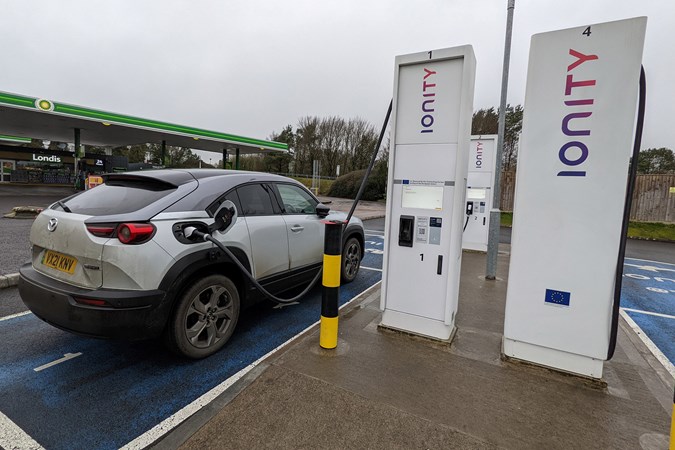
I won’t bore you all with the cataloue of failed or slow charges and queues, other than to present you with these facts. My first 250-mile leg of the journey took nine hours (instead of the usual four and a half), while the second 170-mile leg took six hours rather than the three and a half you’d normally expect.
I was hampered by a lack of homecharger in Cumbria, but as I see it, that’s a test that many EV drivers will have to face going forward.
Public charging fiasco, part one
This is the first leg of the journey, from East Midlands to West Cumbria.
First charge: Failed. A single chargepoint at a motorway service station, occupied by a Tesla Model 3, with another queuing behind it had me seek another. Total time lost 20 minutes.
Second charge: Success. A 15-mile detour into a local town and one successful charge. Total time taken – one hour, plus 45 minutes additional driving
Third charge: Success. Quick top-up, 30 minutes, plus 10 minutes’ detour.
Fourth charge: Success. 80% recharge. Needed to negotiate with another EV driver to get mine on to the charger – then when I returned two other EVs were awiting behind me. Time taken 45 minutes.
Fifth charge: Partial success. Needed to reconnect several times, due to comms error between the car and charger. Time taken, one hour, plus 10 minutes’ detour.
Sixth charge: Partial success. Fast charger delivering just 10Kwh, but this was an optional one to give me some ‘gas in the tank’ for the second leg of the journey.
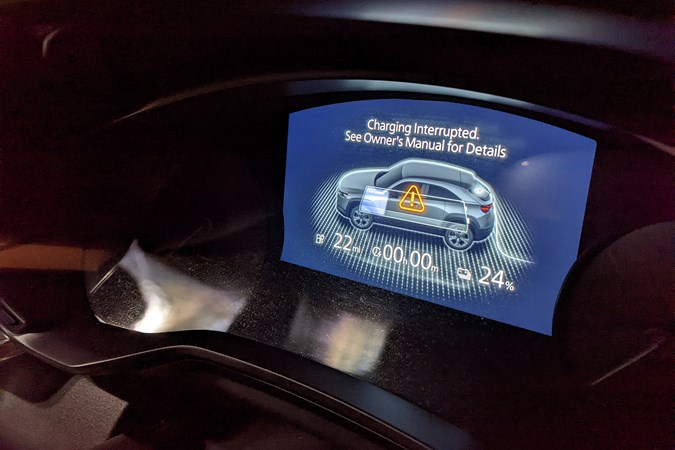
Public charging fiasco, part two
This is the second leg of the journey, from West Cumbria to Loch Lomond
First charge: Partial success. Charger delivered 12kWh, but one hour stop was combined with breakfast
Second charge: Failure. None of the four Ionity chargers would communicate with the Mazda MX-30. Time wasted 25 minutes.
Third charge: Success. New charger set to free vend! Time taken one hour, but no diversion needed.
Fourth charge: Success. But 20 minutes to get the new app up and running. Then one hour 10 minutes to charge up completely.
So, as you can see, the Mazda’s limited range is a problem is you have to expose yourself to the chaos and uncertainty of public charging. if it had a 250-mile range, much of this hassle could have been avoided, and I’d have not wasted so much time getting from one end of the country to another.
But this is the issue. Public charging is a mess, and it gets worse the further north you go. It’s not as if I was unprepared for the journey, and I have lots of EV experience to call upon. But even I was exasperated by this journey, and wished that I’d taken the journey in my Skoda Enyaq iV.
You have been warned.
Update 7: Conclusions
Our time is up, and the MX-30 returns to its maker after a year on fleet
Long story short – if you’re a suburban empty-nester, with a shortish commute and have a homecharger, this is the EV for you…
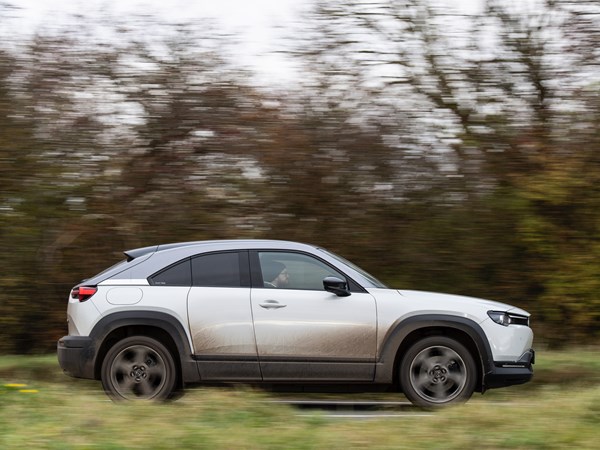
With our year with the MX-30 coming to an end, it’s time to take stock and draw some conclusions. This stylish little EV earned a number of fans within the Parkers team, not least because of its interesting design, beautifully built and trimmed interior and tidy handling and ride.
We’ll go further. The MX-30 is a fabulous place in which to spend time. The build quality is top notch and the materials used have a premium feel that really endears you to the car. We love the use of cork inside, too, which appears not to have deteriorated at all in the months we’ve owned the car.
On the road, it impresses too – with sharp, accurate steering, tidy handling, and a sense of fun that’s very unusual for an electric car. In all, it’s an appealing vehicle that’s easy to like. But there is a catch…
Range and charging…
Mazda says that the MX-30’s 35.5kWh battery pack has its advantages. It’s relatively quick to recharge and because it’s smaller and lighter than the industry average, it really does make it good to drive.
But for us, the benefits are far outweighed by the disadvantages. The short range combined with the poor current state of the UK charging network makes this a car you won’t want to take on any longer journeys without serious planning. In our experience, the poor range is further limited in the cold weather – expect no more than 80 miles of realistic range in winter conditions.
Should you buy one?
The MX-30 is an appealing thing that’s limited to a small number of people. As a city car, it’s not really compact enough, and it’s too cramped to be a serious proposition as a familiy car. The rear doors might look good, but prove surprisingly impractical. That short range means (currently) you won’t want to buy one if you regularly travel distances in it.
So, who is it for? If you’re an empy nester with a driveway, and a shortish commute, as well as access to a car with a longer range, then the Mazda MX-30 is worth having a look at. For the rest of the UK’s car buying public, it’s not so easy to recommend – as with all EVs, it’s an excellent thing to drive, but in this case, it’s simply too compromised for too many people to consider.
| Mazda MX-30 GT Sport Tech |
|
| Current mileage | 7,520 |
| Electrical efficiency | 3.2kW per mile |
| Parkers real-world range | 111 miles |
| Parkers ‘MPP’ (Miles Per Pound) calculation | 10.3/24.7 (home/public charging) |
| Car joined Parkers fleet | March 2021 |



